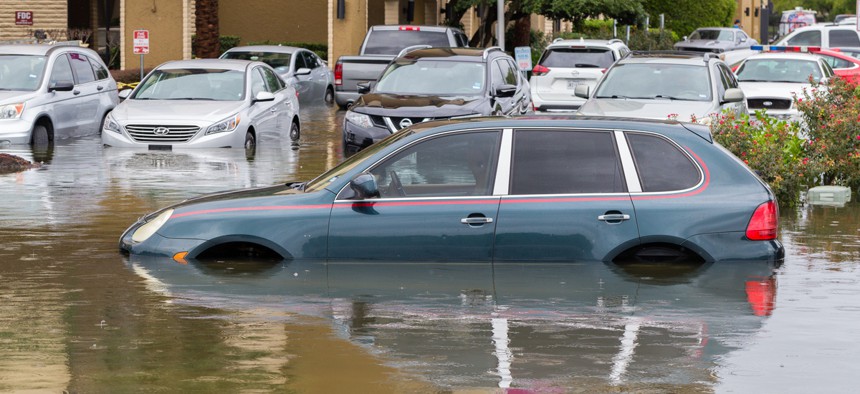The Vital Role of Social Media in the Eye of the Storm

Shutterstock
Five communications lessons one hospital learned during Hurricane Harvey.
HOUSTON — When Hurricane Harvey hit, our social team at Texas Children’s Hospital anticipated only a few patient inquiries via Facebook and Twitter. We ended up working 16-hour days for one week, monitoring and answering patient inquiries on social media to ensure the community could access vital information.
“I'm 38 weeks pregnant. How do we get to the hospital?"
"I'm currently in labor. Help!"
"My kid’s heart meds ran out. Where do we go?"
The experience illustrated the power of social media to maintain a high level of service to the community in times they need it most.
Our social media team’s goals at Texas Children’s Hospital are to drive positive experiences, build a group of advocates and protect the hospital’s online reputation. Social media is a key channel for us to reach patients and the surrounding Houston community. According to Internet World Stats, 47 percent of the population of Texas are Facebook users. We’ve embraced social media as a key strategy to reach our audience, in “blue-sky” periods and during emergency scenarios like Hurricane Harvey.
Social media gives Texas Children’s Hospital a direct line to patients and the public. We treat every person who leaves a question or comment on our Facebook pages as if they were someone who walked through the hospital doors. Social media allows us to connect with the public at scale, and take more complex inquiries offline to remain compliant. Maintaining positive experiences is important in-person, so the same level of service should be applied online; it can mean the difference between keeping and losing a patient family in our system.
During Hurricane Harvey, we wanted to ensure we continued to be responsive despite the emergency. We used social media to ensure people got the information they needed immediately. We achieved our goal of answering 100 percent of the inquiries that came through on our Facebook pages, helping to deflect some of the volume from other channels to contact the hospital. Social media enabled us to serve patients immediately and in real time during an emergency scenario.
As you develop or optimize an existing strategy to utilize social media in emergency communications, keep these five lessons we learned during Hurricane Harvey in mind:
- Speed matters: Use a tool to help you organize multiple channels and stay organized. Our team used Hootsuite to see all inquiries coming to our social media channels in one place. Despite our team being evacuated to different areas of Houston, we used the dashboard as a central hub to view all inquiries and respond without duplicating efforts. During Harvey, we provided information about access to each of our hospital sites or referred them to the appropriate contact. This approach allowed us to answer questions within 5-10 minutes of receipt.
- Monitor 24/7: In an emergency, it’s no longer a 9-5 job. Questions will come in 24/7 so expect to work outside of normal hours. We worked over the weekend and well into the evenings each day throughout Hurricane Harvey. To keep the speed of our response rate high, we worked outside of our typical hours and continued providing responses as we received them. In emergency situations, you never know what could bubble over if you look away for an extended period of time.
- Social media doesn’t belong to one person: Social media shouldn’t be one person’s job. Have multiple people assigned to different tasks to break up the work into manageable chunks. During Harvey, we assigned our team of three specific platforms to monitor. We set up separate streams for two Twitter accounts, six Facebook pages and Instagram. Each member was responsible for answering inquiries on their assigned platform. We developed 10 pre-approved responses to common questions and used Hootsuite to keep tabs on and respond to all the questions.
- Be human: In emergency situations, people are stressed and time is of the essence. However, you need to stay human and relatable. The person on the other end of the line could be going through their worst day. Using names and being thoughtful in your messages goes a long way.
- Over-communicate: Share frequent updates to show your organization’s dedication to keep people informed. We recommend posting two to three times a day, or more depending on how frequently the situation is changing. During Harvey, we had people asking when the next update would be shared. Be proactive and over-communicate; that includes communicating about the next communication!
Social media is feared by many, especially in areas like healthcare where organizations must comply with regulations. Coupled with the countless stories of social media slip-ups going viral make social media intimidating. But today, social media is no longer a nice to have but an integral piece of your communications strategy. Embrace it because emergencies aren’t a matter of if, but when.
Cara Lovan is a senior social media specialist at Texas Children's Hospital in Houston.
NEXT STORY: Supreme Court Will Hear 2 Cases Impacting State Government This Week





